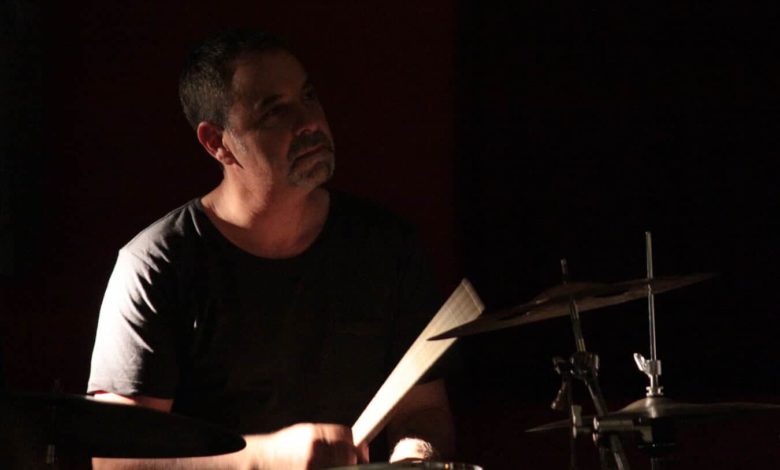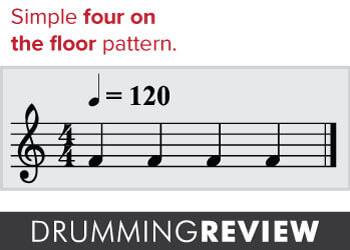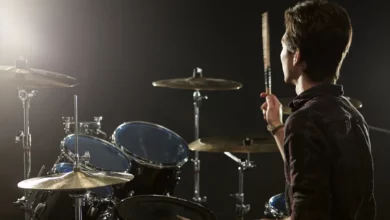
We may earn a commission from the affiliate links on this site. Learn more›
If you’re a drummer, there’s no doubt in my mind that you have heard or have used the phrase “four on the floor” before.
This rhythmic pattern is the very bedrock of many popular styles of music. As a working drummer, it’s important to embrace this style, even if it’s not the most exciting thing to play.
Drummers of the 80s who used electronic drum kits in groups like Dead Or Alive or Depeche Mode heavily relied on four on the floor.
Four on the floor is still extremely common today being heard in many EDM tunes and club bangers.
What is four on the floor?

For all of you non-drummers out there, you may not know exactly what four on the floor is. It’s a very simple pattern played with the bass drum accenting quarter notes in common time (a simple 1, 2, 3, 4).
Four on the floor is primarily utilized in electronic dance music and disco, though it is common in many other genres of music. The picture to the left shows the rhythm: a bass drum plays hits on every quarter note beat in common time.
The origin of the term “four on the floor” is still being debated and speculated, though it is probable that the term was coined in the 1970s when disco music was all the rage. Take a listen to any major hit song from this era and you’ll most likely hear this pattern.
Four on the floor was very prevalent in the 1970s. Earl Young is considered to be the king of disco drumming:
On the tune “The Love I Lost” from Harold Melvin and the Blue Notes, Young features the pattern throughout the song, along with upbeat hi-hat playing that reminds me of modern electronic music.
Use in jazz
Though not an overly bass-drum heavy style of music, jazz does incorporate this rhythm more than you may think. In lighter styles, drummers use a technique called “feathering” the bass drum when playing four on the floor.
Feathering the bass drum can be heard on many jazz records from drummers like (but not limited to) Elvin Jones, Buddy Rich, or Art Blakey.
It’s a very light tap of the drum just to give the perceived feel of a groove.
In my experience, getting this right is very difficult. Feathering the bass drum is extremely nuanced and requires a great deal of restraint to not overplay.
Use in reggae
Typical reggae music generally favors beat three. When I play in the style of reggae, I tend to play a simple hi-hat pattern with a rim click and a bass drum hit on beat three, whether swung or straight.
This is just one way to play the style. In fact, drummers sometimes use four on the floor in reggae, as well.
Carlton Barret, known for playing with Bob Marley and the Wailers, used four on the floor on tunes like “Exodus” and “Is This Love.”
Use in electronic dance music and pop
Today, you’ll hear the most utilization of four on the floor in EDM, hip-hop, and pop music. By simply turning your radio dial to any popular station, you’ll hear the heartbeat groove in most songs.
EDM genres that have developed from house and techno will be more oriented to the rhythm. Genres such as drum and bass and liquid will usually feature a more active, complex, and rhythmic groove rather than a simple bass drum pattern.
Embracing four on the floor as a drummer
As I’ve stated previously, I’m not one to get excited about playing this pattern. It’s extremely boring and very easy to play.
My problem lies in wanting to play a part that is interesting to the listener. That being said, sometimes we have to play things we do not like.
If your dream gig is being a session drummer, there are going to be parts you will not enjoy playing but you will have to put on a happy face and do it anyway.
Sometimes the music trumps the drum part. We, as drummers, have to remember that we are not the center of attention and it is very easy to overplay and wreck the magic of a great song.
We all know drummers who play way too much for a given style. Four on the floor may just be a simple bass drum groove, but it is also a reminder of what music is in its purest form.
Featured image credit to Andrew Lorien via Flickr.com



